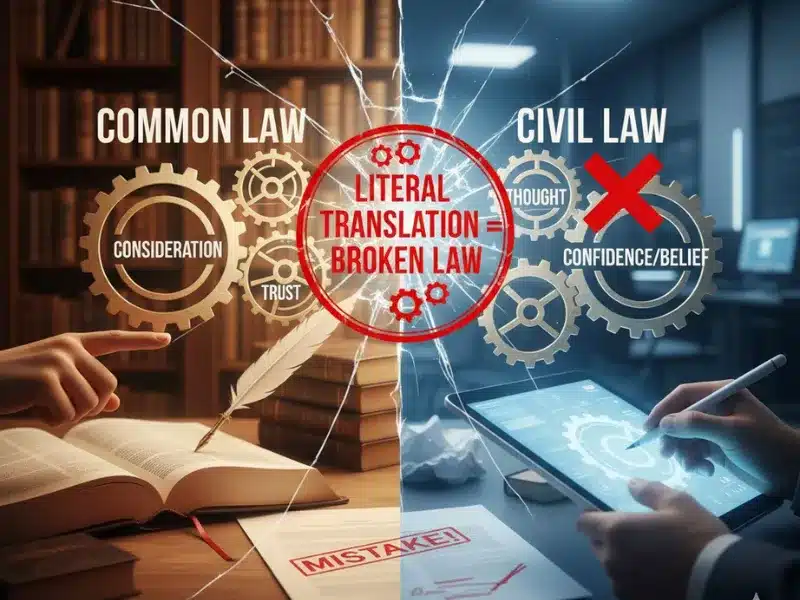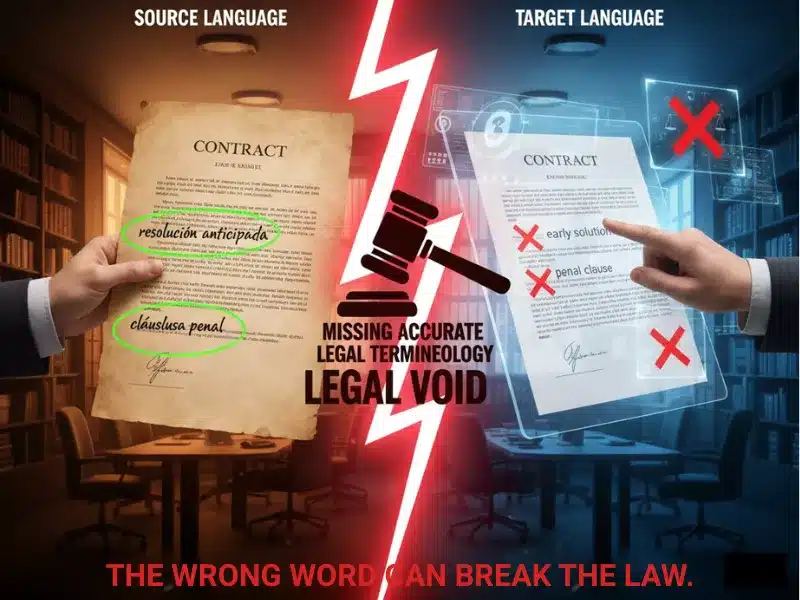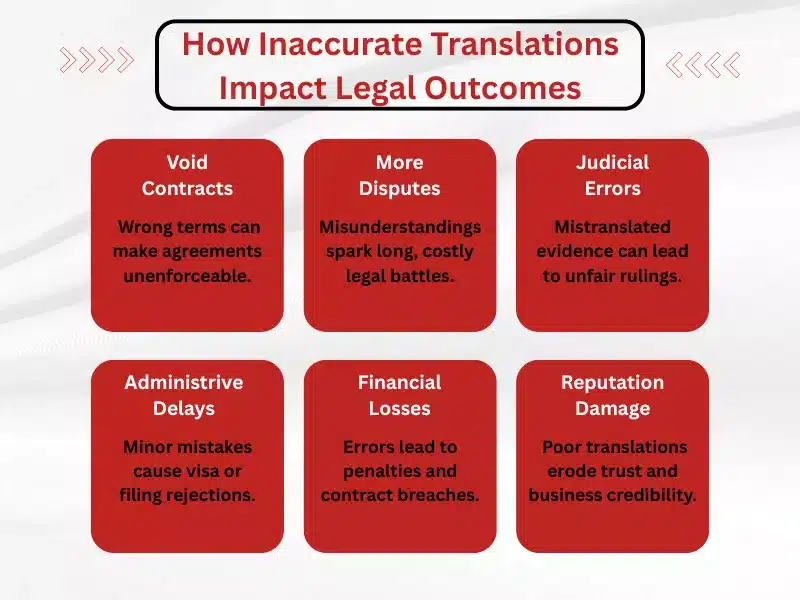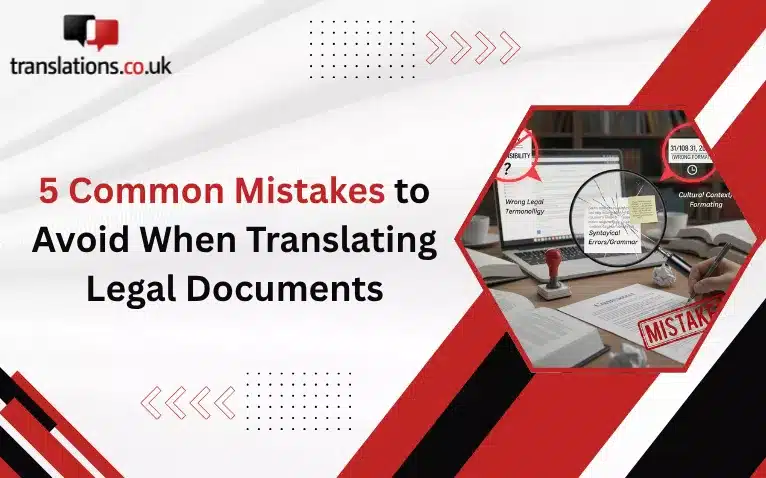Legal document translation plays an integral role in global business, international transactions, immigration, intellectual property, and foreign court proceedings. The translation of legal contracts or documents must preserve the precise meaning of the original legal text across different languages to ensure compliance with various legal systems and uphold the legal validity and intent.
Errors in legal translation, even a single one, can result in void agreements, legal disputes, or significant financial loss. This is why the importance of accuracy in legal translation is absolutely indispensable.
In this article, we will specifically highlight 5 common mistakes to avoid when translating legal documents. We will also discuss how professional translation services for legal documents can save you from making those costly mistakes in the first place!
These five common mistakes in legal document translations can lead to significant errors in legal proceedings.
1. Literal Translation Ignoring the Legal Context

One of the most common mistakes in legal translation leading to legal issues is translating text word-for-word. This approach fails to consider the distinct legal systems and practices shaping the language.
Since legal language is deeply embedded in a specific judicial and cultural context, a direct, literal translation often distorts the document’s intended meaning and enforceability. The issue is not just about replacing words, but ensuring the translated text holds the same legal weight in a different system.
For example:
The English term “consideration,” which is a vital element for a contract to be binding in common law, has no direct equivalent in many civil law systems. Translating it literally might result in a word that means “thought” or “reflection,” which carries no contractual weight, thus undermining the validity of the translated agreement.
Similarly, the term “trust” is a foundational concept in common law systems but may not exist in the same form in civil law countries. A literal translation could create a nonsensical legal concept within the target jurisdiction.
Challenges in translating legal documents arise because legal terms are shaped by judicial interpretation and cultural norms, meaning a direct word-for-word rendering is often insufficient.
2. Overlooking Cultural Differences

Another critical error is ignoring the cultural nuances embedded in legal documents. Legal concepts and their applications can differ significantly between cultures, even if the languages seem similar. What is standard practice in one culture may not be applicable or could even be misinterpreted in another. When translators overlook these cultural differences, the translated documents can lead to confusion and disputes.
Why Is Cultural Context Crucial in Legal Translations?
Cultural context is crucial because it governs how legal principles are understood and applied. Legal systems vary greatly, shaped by historical and social traditions that influence everything from contract formation to personal rights.
A failure to adapt the translation to the target culture can result in a document that is not just inaccurate in legal meaning, but also legally ineffective. Legal translation isn’t merely a linguistic task; it involves conveying concepts in a way that aligns with the target jurisdiction’s cultural and legal expectations.
3. Failing to Maintain the Original Structure
Various types of legal documents often contain highly specific and methodical formatting, including.
- Numbered clauses
- Appendices
- Signature blocks
- Official seals
A common mistake is failing to replicate this structure precisely in the translated version. Any deviation from the original layout of the legal content can
- Cause ambiguity
- Lead to rejection by official bodies
- Or, create grounds for misinterpretation of legal obligations
Translations often need to mirror the source document’s structure to be considered valid.
For instance, if a court bundle with translated evidence does not maintain consistent formatting and clause numbering, a judge could rule it inadmissible.
Similarly, authorities may reject a certified translation if the layout, seals, or signature placements do not match the original.
4. Missing Accurate Legal Terminology

The specialised vocabulary of law demands absolute precision. Missing or inaccurately translating a single term can drastically alter the meaning of a document.
Legal terminology in translations requires more than just bilingual fluency; it demands deep knowledge of the specific legal field in both the source and target languages. This is especially true for complex legal documents such as patents, contracts, and court filings.
Some common errors include:
- Using generalist translators who are unfamiliar with the precise legal jargon required.
- Translating a phrase like “resolución anticipada” in Spanish as “early solution” instead of the correct “early termination.”
- Rendering “cláusula penal” as “penal clause” when it should be translated as a “liquidated damages clause” in the context of English commercial law.
These translation mistakes in legal contracts underscore the necessity of using professional legal translators with specialised expertise who help you avoid a misinterpretation of legal duties and rights.
5. Neglecting to Include a Certification Statement

A frequent and serious oversight in official translations is the failure to include a certification statement. This is a formal declaration signed by the translator or translation company attesting to the accuracy and completeness of the translation.
Many government agencies, courts, and other official bodies will not accept a translated document without this certification.
Forgetting this step renders the translation invalid for official purposes, which can halt legal proceedings or cause significant delays.
For example, a court might reject a contract translation (even if the language itself is flawless) simply because it lacks the certified translator’s official statement.
Using machine translation tools is particularly risky in this regard, as they cannot provide the required human-certified assurance of accuracy.
How Can Inaccurate Translations Impact Legal Outcomes?

The Consequences of poor legal translation extend far beyond simple misunderstandings. They can fundamentally alter rights, obligations, and the outcomes of legal proceedings. An inaccurate translation introduces ambiguity and error into a process that demands absolute precision, creating a cascade of negative effects. Here are the top ones among the many legal consequences.
Compromised Legal and Contractual Validity
At its core, a poor translation erodes the legal integrity of a document. It can misrepresent the fundamental rights and obligations of the parties involved, often by changing a single crucial term. This can lead to:
- Voidable Contracts: When key contractual terms are altered during translation, the agreement may no longer reflect the original intent, potentially making it void or unenforceable.
- Escalated Disputes: Ambiguity created by translation errors can become the basis for lengthy and expensive litigation, as parties dispute the true meaning of the terms. The serious legal implications of using incorrect specialised terminology can distort a document’s true purpose and create unforeseen legal vulnerabilities.
Severe Judicial and Administrative Setbacks
In official proceedings, the impact of flawed translations can be particularly devastating.
- Miscarriages of Justice: In a courtroom, a mistranslated testimony, piece of evidence, or criminal record can lead to a wrongful conviction or an incorrect judgment by distorting the facts presented.
- Administrative Rejection and Delays: In immigration and business law, even minor translation errors in supporting documents can cause significant administrative setbacks. This often results in incorrect visa denials, rejected business filings, and costly delays that disrupt personal and commercial plans.
Significant Financial and Reputational Damage
Beyond the immediate legal dispute, inaccurate translations carry tangible legal repercussions and reputational harm. Incorrect translations that lead to breaches of contract can result in unexpected financial penalties, damages, or other losses. Furthermore, for businesses operating internationally, translation errors can severely damage their reputation, erode trust with partners, and lead to a loss of business opportunities.
How can Businesses Ensure Accuracy While Translating Legal Documents?
Now that you have a clear picture of common mistakes and their consequences, you might be wondering how to avoid legal translation mistakes. The best way to avoid common mistakes in legal document translation in the first place is to work with a professional legal translation services provider. They have qualified legal linguists who have a thorough understanding of the nuances of legal context and various legal systems for cross-border legal translation. Let’s understand what role a Legal Translator plays in Ensuring Accuracy in Legal Translations in the next section:
What Role Does a Legal Translator Play in Ensuring Accuracy in Legal Translations?

First of all, a professional legal translator is far more than a linguist. They are a subject-matter expert who ensures a document’s legal validity and intent are preserved across jurisdictions.
These are translators who specialise in legal fields, and their contribution is crucial for mitigating risk, protecting the client’s legal interests. A true legal expert in this role is defined by specific qualifications and a rigorous methodology.
Core Professional Qualifications
- Dual Expertise: They possess qualifications in both linguistics and law. This often means having a law degree or extensive, specialised training in a specific area of legal practice, such as intellectual property, M&A, or litigation.
- Knowledge of Comparative Law: They are adept at navigating different legal systems (e.g., Common Law vs. Civil Law). Furthermore, they understand how procedural and conceptual differences within the target legal system can impact translation. This is crucial for interpreting complex legal nuances that lack a direct one-to-one equivalent.
- Focus on Conceptual Fidelity: Instead of word-for-word translation, they focus on conceptual equivalence. For the sensitive documents they handle, such as patents, court orders, or merger agreements, their job is to ensure that a legal concept in the source text achieves the same legal effect and has the necessary legal standing in the target language.
Their Methodology for Achieving Accuracy
To deliver accurate legal translations, an expert follows a structured and multi-layered translation process to maintain the crucial aspect of certified translations. This includes:
- Terminology and Style Guide Development: Before translation begins, glossaries of critical legal terms are created and approved. This step ensures consistency, especially for large-volume projects.
- Leveraging Technology for Consistency: Tools such as translation memories are utilised to store previously translated segments. This guarantees that a specific term is translated identically every time it appears, protecting the integrity of the information in the documents.
- TEP (Translation, Editing, Proofreading): A three-stage quality assurance protocol is standard. An initial accurate translation is completed, followed by a review from a second, equally qualified legal linguist who checks for errors and refines phrasing. A final proofreading step polishes the text.
- Certification and Formal Attestation: For documents requiring official acceptance, a certified translation service provider offers a formal statement of accuracy. This final step is essential for ensuring your documents are accurate and valid for submission to courts, government agencies, and regulatory bodies.
Following this robust methodology is the only way to produce a genuinely accurate legal document translation that is legally sound and fit for purpose.
Professional vs Amateur Legal Translation
Lastly, the operational and financial distinction between a professional translation service and an amateur translator is critical when considering risk management and data security.
| Main Concern | Professional Service | Amateur Translator |
|---|---|---|
| Risk and Liability | Assumes professional liability for high-quality legal translation work, often backed by Errors & Omissions (E&O) insurance to cover potential damages. | Offers no professional accountability; all financial and legal risk of translation errors falls directly on the client. |
| Confidentiality | Bound by formal Non-Disclosure Agreements (NDAs) and uses secure, encrypted platforms for document handling. | May use unsecured channels (e.g., personal email), posing a significant risk to client confidentiality and data security. |
| Project Scalability | Equipped to handle large, complex projects with tight deadlines through dedicated project managers and teams of vetted linguists. | Acts as a single point of failure; lacks the capacity and infrastructure to manage high-volume or urgent requests consistently. |
| Post-Delivery Support | Provides ongoing support and clarification for translated documents as part of their service commitment. | Typically offers no support after delivery, leaving the client without recourse for future questions. |
| Regulatory Compliance | Experienced multilingual legal document services are often compliant with data privacy regulations like GDPR. | Generally unaware of or not compliant with international data protection and privacy regulations. |
| Cost vs. Value | Higher initial investment that provides long-term value by minimising risk and ensuring legal validity. | Lower upfront cost that can lead to higher long-term expenses from fixing errors, disputes, and legal challenges. |
Given the significant risks involved, choosing professional translation services is the only way to secure high-quality legal documents that are defensible, accurate, and valid in the target jurisdiction.
Conclusion
Navigating the complexities of legal translation requires precision and expertise. Understanding the Common Mistakes to Avoid When Translating Legal Documents is the first step, but the ultimate solution is professional diligence. Entrusting your documents to non-specialists is a significant risk. For guaranteed accuracy, compliance, and peace of mind, partner with the certified legal experts at Translations.co.uk to protect your legal interests and ensure your documents are valid in any jurisdiction.
Frequently Asked Questions
Who is the best legal document translation service provider in the UK?
The best provider is one who combines certified accuracy, a team of verified legal expert translators, and a secure, confidential process. Translations.co.uk is a leading UK provider that meets these criteria, offering specialised legal translations backed by robust quality assurance and full certification recognised by UK authorities, ensuring your documents are handled with the highest level of professionalism and care.
How to get certified legal document translations in the UK online?
You can get certified translations online through a secure and simple process with Translations.co.uk. Here’s how it works:
- Upload & Specify: Visit our secure portal to select your service (e.g., Certified), choose your languages, and upload your document(s). You can also select an urgent delivery time if needed.
- Get an Instant Quote: Instantly receive a comprehensive, no-obligation quote with the full cost and a clear delivery date.
- Secure Checkout: Enter your details and complete your order using our secure online payment system.
- Receive by Email: Your certified, professionally formatted translation will be delivered as a print-ready PDF directly to your email within the agreed timeframe.
Can AI or Google Translate be used for legal documents?
AI tools and services like Google Translate can help understand the general meaning of simple texts. However, they are not suitable for legal documents. These tools cannot fully grasp legal context, cultural nuances, or precise terminology. Using them can result in errors that may invalidate the document. Uploading sensitive information also poses serious confidentiality risks. Additionally, these tools cannot provide the official certification required by courts or legal authorities.
What affects the cost of a professional legal translation?
Several factors influence the price:
Complexity of the document: Simple documents like witness statements cost less than complex contracts or patent filings.
- Language pair: Rare languages may require specialized translators, which can increase cost.
- Turnaround time: Faster delivery often comes with a higher price.
- Level of certification: Standard accuracy certification is usually cheaper than notarization or court-approved certification.
How is the confidentiality of my sensitive legal documents ensured?
Professional translation services use strict protocols to protect sensitive documents. They operate under Non-Disclosure Agreements (NDAs) and secure, encrypted platforms for file transfers and communication. This ensures compliance with data privacy rules and offers a level of security that free tools or amateur translators cannot match.
- The Importance of Certified Translation Service: What, Why, When, How? - 16th October 2025
- 5 Common Mistakes to Avoid When Translating Legal Documents - 10th October 2025
- The Ultimate Guide on Business Translation - 12th May 2023

